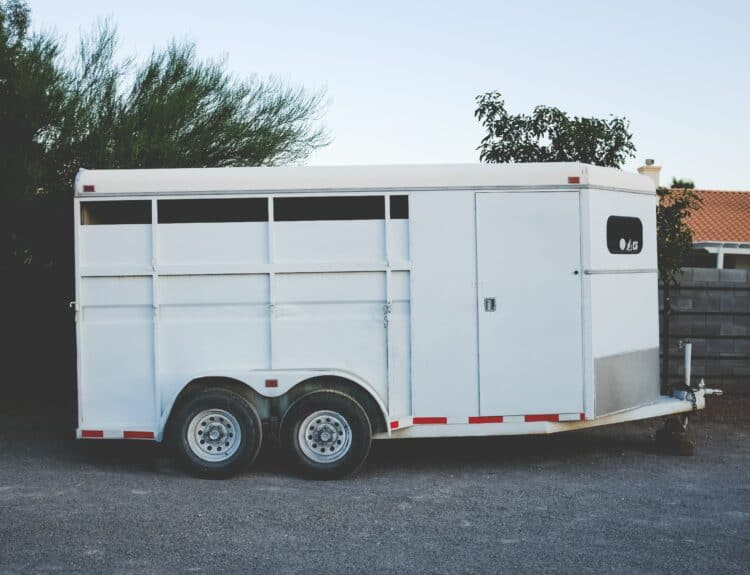Using tire studs is a highly effective way to enhance traction and minimize the likelihood of accidents. Tire studs are small metal spikes inserted into the tread of studded snow or winter tires.
Even though motorists have used tire studs for over 100 years, the ones we know today became popular in the United States in the 1960s. Tire studs are controversial, with some states banning them and others legislating their use.
Researchers have published numerous studies with varying conclusions on the effectiveness of tire studs in boosting traction. For example, a study by Rober Scheibe, a principal mechanical engineer at the University of Washington, concluded, “From the standpoint of traction alone, studded tires, when new, often provide some benefit over other tire types on ice-covered roads when the temperature is near freezing.”
So, you should consider tire studs if you want to boost your RV traction this winter. But what are they, and how do they work? Do they have any benefits?
Are there any restrictions or regulations regarding using RV tire studs in specific areas or at certain times of the year? Welcome to this comprehensive guide, where I will answer all these questions and more.
What Are Tire Studs, And How Do They Work?
Tire studs, also known as small metal spikes, are inserted across the tread of winter tires in a staggered pattern. These lightweight spikes slightly protrude from the rubber tread surface, enhancing traction by penetrating packed snow and ice-covered roads.
The studs stick out from the tire’s tread and help it grip the surface better by digging in. This keeps the tire in contact with the road, reducing the chances of skidding or sliding.
Tire studs, though small, possess remarkable durability owing to their composition of tungsten carbide or hardened steel. These materials endure the demanding conditions encountered during driving. The strategic embedding of these studs within the tire’s tread pattern can occur through the original tire manufacturer’s installation or aftermarket services.
Once the frigid embrace of icy or snowy surfaces greets the RV, the studded winter tires spring into action. As the tire relentlessly rotates, these stud warriors penetrate the frozen terrain, facilitating traction by embedding themselves within the icy or compacted snow. This tenacious digging motion enhances grip, preventing the tires from relinquishing their hold.
The remarkable interaction between the tire studs and the road empowers the driver to maneuver with heightened confidence, skillfully accelerating, braking, and executing turns.
It’s important to highlight that tire studs are especially useful when driving your RV in specific conditions. They are typically found on studded snow or winter tires specially designed for challenging winter weather. These tires have unique tread patterns and carefully placed studs that are specifically created to provide optimal performance on icy or snowy roads.
Benefits of Using RV Tire Studs in Winter
Here are the benefits of using RV tire studs during winter:
- Improved traction: The studded snow tires dig into the surface when driving in these slippery conditions, creating extra grip. This allows the tires to maintain better contact with the road, reducing the risk of slipping or sliding. Improved traction allows you to accelerate, brake, and turn more effectively, providing a safer driving experience.
- Reduced braking distance: One of the critical benefits of tire studs is their ability to reduce braking distance on icy roads. By biting into the surface, studs enable the tires to grip the road better during braking maneuvers. This can be crucial in emergencies where shorter braking distances can help avoid accidents or collisions.
- Enhanced stability: Providing additional grip, tire studs help prevent wheel spin and minimize the chances of losing control of the vehicle. With increased stability, you can navigate turns and corners more confidently, reducing the risk of skidding or veering off course.
- Better acceleration: Wheels often struggle to find traction, making it difficult to get going. Luckily, we have tire studs to help us out. These accessories dig into the icy surface, giving us a stronger grip. They improve our ability to accelerate, reducing wheel spin. As a result, we can handle icy hills and slippery starts much more easily.
How Long Do Tire Studs Typically Last?
Tire studs for your RV may typically last about 3,000 to 5,000 miles or three to four winter seasons before they require replacement. Several factors, such as the type of studs, driving conditions, and driving habits, may influence the lifespan of tire studs. However, it’s important to remember that their effectiveness may gradually decrease over time.
The material used to make tire studs determines their longevity. Tungsten carbide or hardened steel is the material of choice for top-grade studs. These materials are resistant to wear and abrasion, effectively prolonging the life of the studs.
Regularly checking your tire studs for any signs of wear and tear is crucial. The studs come into contact with the road surface and may experience gradual erosion, reducing traction. If you notice significant wear or the studs start to loosen or fall out, it’s time to replace them.
Driving frequently on dry or paved surfaces can speed up stud wear since studs do not perform optimally in such conditions. It’s advisable to remove studded tires when winter driving conditions have subsided to extend the lifespan of the studs.
How to Ensure Your Studded Winter Tires Last Longer?
Here are some tips you can follow to increase the longevity of your studded winter tires:
- Regular inspection: Check your studs regularly for signs of wear, such as a significant reduction in height or visible damage. Inspect the studs before each winter season and periodically throughout the season.
- Replace worn or loose studs: If your studs are significantly worn, loose, or fall out, it’s time to replace them. This will help maintain optimal traction and safety.
- Avoid unnecessary driving on dry surfaces: Studded tires should be used in icy or snowy conditions. Limit driving on dry or paved surfaces, as this can accelerate stud wear and increase road noise.
Are There Restrictions Or Regulations Regarding RV Tire Studs In Specific Areas Or Times?
Indeed there are restrictions and regulations regarding using tire studs in specific areas and times.
Jurisdictions implement rules to safeguard road integrity and prioritize safety. Here are some key points to consider:
- Variations across regions: Regulations on tire studs can diverge between countries, states, provinces, or even local municipalities. It is crucial to familiarize yourself with the specific regulations in your area before opting for tire studs.
- Complete ban: In certain regions, tire studs are prohibited due to potential road damage concerns. Irrespective of road conditions or the time of year, using tire studs in these areas is illegal.
- Seasonal restrictions: Some regions allow tire studs only during designated months or within specified winter seasons. This approach helps minimize the impact on road surfaces when wintry conditions are most prevalent.
- Limited usage areas: Tire studs may be restricted to certain roads or designated zones in specific regions. This limitation could be in place to mitigate the impact on road surfaces or prioritize studded tires on exceptionally icy or hazardous routes.
Conclusion
Tire studs emerge as a potential solution to boost traction and ensure your safety on the road when it comes to winter driving conditions during your RVing life. These small additions firmly grip icy and snowy surfaces, providing enhanced stability, reduced braking distances, and improved acceleration.
With tire studs, your winter travels become safer and more manageable, allowing you to navigate challenging conditions confidently.
By embracing the recommendations in this comprehensive guide, you can fully harness the potential of tire studs and elevate your RVing experiences during winter.
Stay informed, prioritize safety, and enjoy the unmatched confidence and control that tire studs bring to your wintry journeys. Let nothing hold you back from embracing the wonders of RVing, even in the face of challenging weather conditions.
FAQs
What are tire studs, and how do they work?
Tire studs are small metal protrusions inserted into tire treads to improve traction on slippery surfaces. When the tire rotates, the studs dig into ice or packed snow, enhancing grip and control.
What are the benefits of using tire studs in winter driving conditions?
Tire studs provide enhanced traction, increased safety, shorter braking distance, and versatility on icy, snowy, wet, or slushy roads.
How long do tire studs typically last before needing to be replaced?
Tire studs last between 3,000 and 5,000 miles, depending on driving conditions, tire type, and stud quality. Regular inspections and prompt replacements are essential for optimal performance.
Are there any regulations or restrictions on using tire studs in certain areas or during specific times of the year?
Some regions or states may have regulations on using studded winter tires, such as limiting their use to specific months or prohibiting them altogether. Check local authorities or the Department of Transportation for any restrictions in your location.






